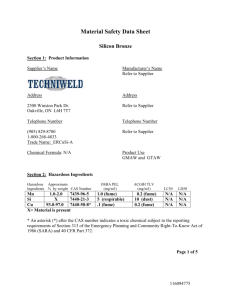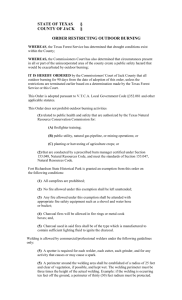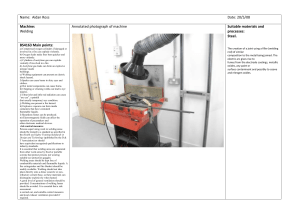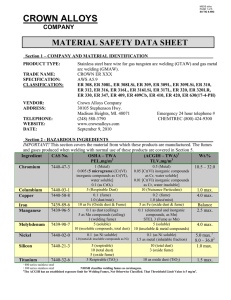Aluminum TIG Rod MSDS () - Weld
advertisement
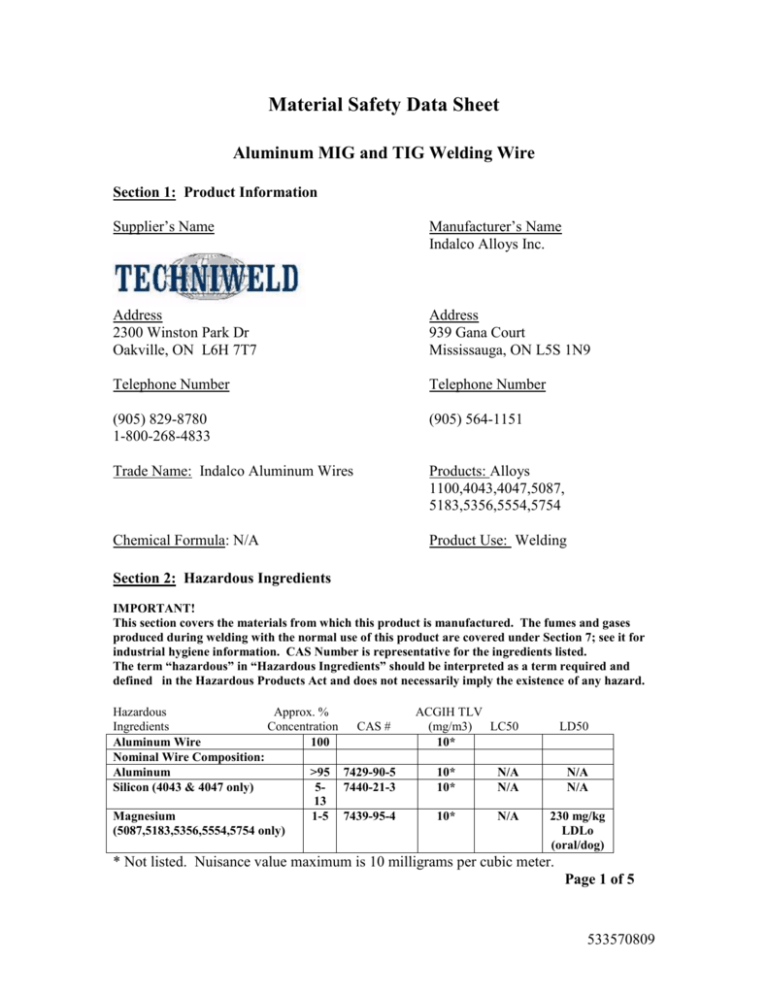
Material Safety Data Sheet Aluminum MIG and TIG Welding Wire Section 1: Product Information Supplier’s Name Manufacturer’s Name Indalco Alloys Inc. Address 2300 Winston Park Dr Oakville, ON L6H 7T7 Address 939 Gana Court Mississauga, ON L5S 1N9 Telephone Number Telephone Number (905) 829-8780 1-800-268-4833 (905) 564-1151 Trade Name: Indalco Aluminum Wires Products: Alloys 1100,4043,4047,5087, 5183,5356,5554,5754 Chemical Formula: N/A Product Use: Welding Section 2: Hazardous Ingredients IMPORTANT! This section covers the materials from which this product is manufactured. The fumes and gases produced during welding with the normal use of this product are covered under Section 7; see it for industrial hygiene information. CAS Number is representative for the ingredients listed. The term “hazardous” in “Hazardous Ingredients” should be interpreted as a term required and defined in the Hazardous Products Act and does not necessarily imply the existence of any hazard. Hazardous Approx. % Ingredients Concentration CAS # Aluminum Wire 100 Nominal Wire Composition: Aluminum >95 7429-90-5 Silicon (4043 & 4047 only) 5- 7440-21-3 13 Magnesium 1-5 7439-95-4 (5087,5183,5356,5554,5754 only) ACGIH TLV (mg/m3) LC50 10* LD50 10* 10* N/A N/A N/A N/A 10* N/A 230 mg/kg LDLo (oral/dog) * Not listed. Nuisance value maximum is 10 milligrams per cubic meter. Page 1 of 5 533570809 Section 3: Physical Data Physical State: Solid Odour and Appearance: N/A Odour Threshold(PPM): N/A Specific Gravity: N/A Vapour Pressure(MM): N/A Vapour Density (Air =1) N/A Evaporation Rate: N/A Boiling Point: N/A Freezing Point: N/A Solubility in Water: N/A % Volatile (by Volume): N/A PH: N/A Coefficient of Water/Oil Distribution: N/A Section 4: Fire or Explosion Hazard Flammable: No. Welding arc and sparks can ignite combustible and flammable products. See CSA W117.2 Section 9.7 as referenced in Section 7. Means of Extinction: N/A Flashpoint: N/A Upper Flammable Limit (% by volume): N/A Lower Flammable Limit (% by volume): N/A Auto ignition temperature: N/A Hazardous Combustion Products: N/A Explosion data-sensitivity to mechanical impact: N/A Explosion data-sensitivity to static discharge: N/A Section 5: Reactivity Data Hazardous Decomposition Products: Welding fumes and gases cannot be classified simply. The composition and quantity of both are dependent upon the material being welded, the process, procedures and electrodes used. Other conditions which also influence the composition and quantity of the fumes and gases to which workers may be exposed include: coatings on the material being welded (such as paint, plating, or galvanizing), the number of welders and the volume of the worker area, the quality and amount of ventilation, the position of the welder’s head with respect to the fume plume, as well as the presence of contaminants in the atmosphere (such as chlorinated hydrocarbon vapors from cleaning and degreasing activities). When the electrode is consumed, the fume and gas decomposition products generated are different in percent and form from the ingredients listed in Section 2. Decomposition products of normal operation include those originating from the volatilization , reaction, or oxidation of the materials shown in Section 2, plus those from the base metal and coating etc., as noted above. Reasonably expected fume constituents of this product would include: primarily aluminum oxide; secondarily magnesium oxide (for 5087, 5183,, 5356, 5554, 5754) and complex oxides of silicon (for 4043 and 4047). Page 2 of 5 533570809 Section 5: Reactivity Data (continued) Maximum fume exposure guidelines for this product are 5.0 milligrams per cubic meter. Gaseous reaction products may include carbon monoxide and carbon dioxide. Ozone and nitrogen oxides may be formed by the radiation from the arc. Determine the composition and quantity of fumes and gases to which the workers are exposed by taking an air sample from inside the welder’s helmet if worn or in the worker’s breathing zone. Improve ventilation if exposures are not below limits. See ANSI/AWS F1.1, F1.2, F1.3, F1.4, and F1.5, available from the American Welding Society, 550 N.W. Lejeune Road, Miami, FL 33126. Section 6: Toxicological Information Effects of Overexposure: Electric arc welding may create one or more of the following health hazards: Fumes and gases can be dangerous to your health. Common entry is by inhalation. Other possible routes are: skin contact and ingestion. Short term (acute) overexposure to welding fumes may result in discomfort such as metal fume fever, dizziness, nausea, or dryness or irritation of nose, throat, or eyes. May aggravate pre-existing respiratory problems (e.g. asthma, emphysema). Long term (chronic) overexposure to welding fumes can lead to siderosis (iron deposits in lungs) and may affect pulmonary function. Bronchitis and some lung fibrosis have been reported. Arc rays can injure eyes and burn skin. Skin cancer has been reported. Electric shock can kill. If welding must be performed in damp locations or with wet clothing, on metal structures or when in cramped positions such as kneeling or lying, or if there is a high risk of unavoidable or accidental contact with work piece, use the following equipment: Semiautomatic DC Welder, or AC Welder with reduced voltage control. Exposure Limits Irritancy of Material Sensitization to Material Carcinogenity 5 mg/M3 N/A N/A See above Reproductive Toxicity Teratogenicity Mutagenicity Toxicologically synergistic products N/A N/A N/A N/A Page 3 of 5 533570809 Section 7: Preventive Measures Read and understand the manufacturer’s instructions and the precautionary label on the product. See Canadian Standards Association Standard CSA-W117.2 “Safety in Welding, Cutting, and Allied Processes” published by the Canadian Standards Association, 178 Rexdale Blvd, Rexdale, ON M9W 1R3 for more details on the following. Personal Protective Equipment: Eye Protection: Wear helmet or use face shield with filter lens shade 12 or darker. Shield others by providing screens and flash goggles. Respiratory Protection: Use respirable-fume respirator or air-supplied respirator when welding in a confined space or general work area. Train the welder to keep his head out of the fumes. Keep exposure as low as possible. Protective Clothing: Wear hand, head and body protection that help to prevent injury from radiation, sparks and electric shock. See W117.2. At a minimum, this includes welder’s gloves, and a protective face shield, and may include arm protectors, apron, hat, shoulder protection as well as dark, substantial clothing. Train the welder not to permit electrically live parts or electrodes to contact the skin or clothing or gloves if they are wet. Insulate from work and ground. Engineering Controls: Ventilation: Use enough ventilation, local exhaust at the arc, or both to keep the fumes and gases from the worker’s breathing zone and the general area. Train the welder to keep his head out of the fumes. Keep exposure as low as possible. Leak or Spill Procedure: N/A Handling Procedures and Equipment: N/A Waste Disposal: Discard any product, residue, disposable container or liner as ordinary waste in an environmentally acceptable manner according to Federal, Provincial and local regulations unless otherwise noted. Storage Requirements: N/A Special Shipping Information: N/A Section 8: First Aid Measures Call for medical aid. Use first aid techniques recommended by the Canadian Red Cross. IF BREATHING IS DIFFICULT, GIVE OXYGEN. If not breathing, use CPR techniques. IN CASE OF ELECTRICAL SHOCK, TURN OFF POWER, AND FOLLOW RECOMMENDED TREATMENT. In all cases, contact a physician. Page 4 of 5 533570809 Section 9: Preparation Information Prepared by: Techniweld (905) 829-8780 1-800-268-4833 Date Prepared: January 1, 2015 The manufacturer believes this data to be accurate and to reflect qualified expert opinion regarding current research. However, the manufacturer cannot make any express or implied warranty as to this information. Page 5 of 5 533570809


